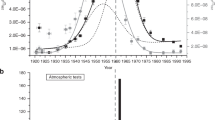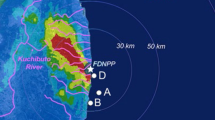Abstract
Reports on the detection of 113mCd in any type of environmental sample have been rare. The 113 mass chain yield is small relative to other longer-lived fission products, such as 90Sr and 137Cs, produced from uranium, plutonium and thorium fissions1. Also, only a small fraction of the 113 chain yield decays to 113mCd (ref. 2). Salter3 estimated that the 113mCd/90Sr activity quotient in thermonuclear fission should be 0.003. He stated that “this ratio is in good agreement with data from a few samples measured in the northern hemisphere prior to 1962 which have no 109Cd”. This, to our knowledge, was the first report of the detection of fission-produced 113mCd in the environment. Salter3 also calculated that 0.062 MCi of 113mCd and 0.25 MCi of 109Cd were produced by activation during the atmospheric detonation of the 1.4-megaton Starfish device on 9 July 1962 over Johnston Atoll. As both 109Cd and 113mCd are produced during neutron activation of stable cadmium, and 109Cd is not a fission product, the last part of Salter's statement is significant. The absence of 109Cd in samples collected before 1962 indicates that all nuclear testing before this time, which included all tests conducted at Enewetak and Bikini Atoiis in the Marshall Islands, could have generated 113mCd only as a fission product. It is therefore important to recognize that 113mCd could be present in other environments contaminated with fission product wastes discharged to the aquatic environment from other nuclear facilities. 113mCd has a half life4 of 14.6 ± 0.1 yr and decays predominantly by beta-particle emission. We present here a preliminary report of 113mCd concentrations measured in sediment and tissue samples of marine organisms collected around different atolls in the Marshall Islands.
This is a preview of subscription content, access via your institution
Access options
Subscribe to this journal
Receive 51 print issues and online access
$199.00 per year
only $3.90 per issue
Buy this article
- Purchase on Springer Link
- Instant access to full article PDF
Prices may be subject to local taxes which are calculated during checkout
Similar content being viewed by others
References
Nethaway, D. R. & Barton, G. W. Lawrence Livermore Laboratory Rep. UCRL-51458 (1973).
Wahl, A. C. J. inorg. nucl. Chem. 10, 1–3 (1959).
Salter, L. P. Radioactive Fallout from Nuclear Weapons Tests (ed. Klement, A. W. Jr) 694, 409–421 (CONF-765, AEC 5 Symp.Series, 1965).
Wahl, A. C. J. inorg. nucl. Chem. 34, 1767–1768 (1972).
Pentreath, R. J. J. exp. mar. Biol. Ecol. 30, 223–232 (1977).
Yamagata, N. Cadmium Studies in Japan: A Review (ed. Tsuchiya, K.) 19–43 (North-Holland Biomedical Press, Amsterdam, 1978).
Mateosian, E. D. & Goldhaber, M. Phys. Rev. 186, 1285–1288 (1969).
Wong, K. M., Noshkin, V. E. & Anglin, D. L. Hlth Phys. (submitted).
US Atomic Energy Commission, Nevada Operations Office Enewetak Radiological Survey Rep. NVO-140, I–III (1973).
Author information
Authors and Affiliations
Rights and permissions
About this article
Cite this article
Noshkin, V., Wong, K., Eagle, R. et al. Concentrations of 113mCd in the marine environment. Nature 287, 221–223 (1980). https://doi.org/10.1038/287221a0
Received:
Accepted:
Issue Date:
DOI: https://doi.org/10.1038/287221a0
This article is cited by
-
The application of XRF analysis in the determination of113mCd
Journal of Radioanalytical and Nuclear Chemistry Letters (1985)
-
Determination of113mCd in natural water
Journal of Radioanalytical Chemistry (1983)
Comments
By submitting a comment you agree to abide by our Terms and Community Guidelines. If you find something abusive or that does not comply with our terms or guidelines please flag it as inappropriate.



